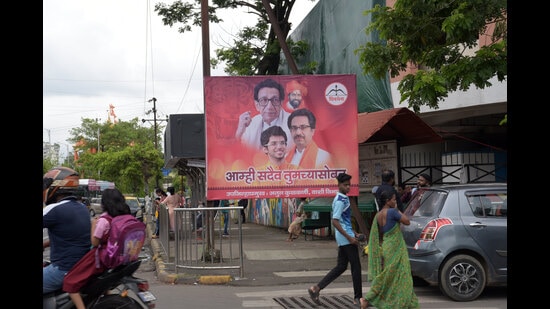Maha lessons for family focussed parties in India
The debacle is an instructive reminder from the BJP to its challengers that no battle is too small to attempt a fight. It is also a warning to all dynasty-driven parties that the family name is not bulletproof to the assaults of the competition, both within and from competitors
Depending on who you talk to in Maharashtra, there are many explanations for the Shiv Sena palace coup.

Some argue that the man often described as the wiliest and most opaque strategist across parties, Sharad Pawar, has been in on the plan all along to try and topple the Uddhav Thackeray-led coalition (Maha Vikas Aghadi). The signs were clear, they say. During the recent elections to the Maharashtra legislative council, when both Sena and Congress legislators allegedly defied party orders and cross-voted, Pawar’s Nationalist Congress Party (NCP) sailed through comfortably, getting five extra votes than it had. In the end, the MVA won one seat less than what it should have, based on its assembly strength.
The other point of suspicion is that the state home ministry is with the NCP, leading many to ask how scores of Sena legislators could make their way to Gujarat without a whiff of intelligence about the move with the police. And then, of course, there is the role of his nephew, Ajit Pawar, which has been under scrutiny for almost three years now. The man who famously joined hands with the Bharatiya Janata Party (BJP)’s Devendra Fadnavis in 2019 for an early morning swearing-in ceremony, only to be described as a Trojan horse as the experiment unravelled, has once again raised eyebrows for his inscrutable behaviour. He recently shared a stage with Prime Minister Narendra Modi and Fadnavis at the inauguration of a temple in Pune.
Another conspiracy theory is that Thackeray was a protagonist in the orchestrated move to break the counter-intuitive coalition with non-BJP parties, ahead of the critical elections to Mumbai’s cash-rich and influential civic body. But the beleaguered chief minister (CM) was overwhelmed by what Sena leaders call “backstabbing by his closest lieutenant [the state urban development minister Eknath Shinde]”. His visible sense of injury and shock belies this theory. So now, Thackeray has decided to fight to the finish. Legal action has been sought against 16 of the rebel MLAs, and clearly, the calculation is that those remaining will not want to resign their seats (a requirement to escape anti-defection laws) and, hence, will return to the family fold.
The abandonment of Hindutva, though touted as a critical reason by the Shinde camp, is a camouflage for the relentless nature of realpolitik. After all, Shinde, as a senior leader of the Sena, was among those who drafted the common minimum programme for the coalition government.
In politics, the most obvious and mundane reason is often the likeliest one. In this case, though Thackeray positioned himself as an approachable, grounded CM, winning accolades during the pandemic from citizens who may have been otherwise ideologically opposed to his party, he did not offer the same access to his party colleagues.
As a result, the Sena’s legislators — as opposed to Sainiks on the streets who are still loyal to the Balasaheb Thackeray legacy — grew increasingly miffed at the coterie around the CM. “We will look within, of course,” Priyanka Chaturvedi, Sena Member of Parliament told me, “but be very clear, there is only one Sena and that is the Sena of Uddhav Thackeray, a man regarded as the best chief minister in India”.
Despite those rallying behind the Thackerays in loyalty, there are essential lessons for not just the Sena, but all political parties, especially family-based regional outfits. The Maharashtra debacle is an instructive reminder from the BJP, yet again, to its challengers. Fadnavis, the former CM, has been chafing at the Sena for walking away from him and his party since 2019. After the cross-voting in the legislative council — and a similar spectacular victory in the Rajya Sabha elections the week before — he triumphantly called out how the BJP got votes from its opponents. Yet, the Sena-led government was complacent. Despite a similar collapse of non-BJP governments in Madhya Pradesh and Karnataka in recent years, the Thackerays got too comfortable.
The Maharashtra Mahabharata is another illustration of the 24x7 machinery that is the BJP, which considers no battle too small to attempt a fight. It is also a warning to all dynasty-driven parties built on power inherited down the generations and concentrated within one family. You may be your party’s biggest brand, but you can still be ousted or come perilously close to it, much like founders of companies have been abruptly eased out by shareholders and venture capitalists. The family name is a shield, but one that is not bulletproof to the assaults from the competition, both within and from outside.
Uddhav Thackeray is counting on the law to live to fight another day. But while he may prevail legally — and it could yet be a protracted war of technicalities — he will still have to manage the politics that brought him to the brink.
What is over is his presumed invincibility as the undisputed leader of the Sena. And for family-run parties across India, that is the message in the tea leaves they need to read.
Barkha Dutt is an award-winning journalist and author
The views expressed are personal
All Access.
One Subscription.
Get 360° coverage—from daily headlines
to 100 year archives.



HT App & Website






